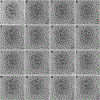Quantification of Choriocapillaris with Phansalkar Local Thresholding: Pitfalls to Avoid
- PMID: 32059979
- PMCID: PMC7214221
- DOI: 10.1016/j.ajo.2020.02.003
Quantification of Choriocapillaris with Phansalkar Local Thresholding: Pitfalls to Avoid
Abstract
Purpose: To demonstrate the proper use of the Phansalkar local thresholding method (Phansalkar method) in choriocapillaris (CC) quantification with optical coherence tomography angiography (OCTA).
Design: Retrospective, observational case series.
Methods: Swept source OCTA imaging was performed using 3×3 mm and 6×6 mm scanning patterns. The CC slab was extracted after semiautomatic segmentation of the retinal pigment epithelium/Bruch membrane complex. Retinal projection artifacts were removed before further analysis, and CC OCTA images from drusen eyes were compensated using a previously published strategy. CC flow deficits (FDs) were segmented with 2 previously published algorithms: the fuzzy C-means approach (FCM method) and the Phansalkar method. With the Phansalkar method, different parameters were tested and a local window radius of 1 to 15 pixels was used. FD density, mean FD size, and FD number were calculated for comparison.
Results: Six normal eyes from 6 subjects and 6 eyes with drusen secondary to age-related macular degeneration from 6 subjects were analyzed. With both 3×3 mm and 6×6 mm scans from all eyes, the FD metrics were highly dependent on the selection of the local window radius when using the Phansalkar method. Larger window radii resulted in higher FD density values. FD number increased with the increase in the window radius but then decreased, with an inflection point at about 1 to 2 intercapillary distances. Mean FD size decreased then increased with increasing window radii.
Conclusions: Multiple parameters, especially the local window radius, should be optimized before using the Phansalkar method for the quantification of CC FDs with OCTA imaging. It is recommended that the proper use of the Phansalkar method should include the selection of the window radius that is related to the expected intercapillary distance in normal eyes.
Copyright © 2020 Elsevier Inc. All rights reserved.
Figures












Similar articles
-
Guidelines for Imaging the Choriocapillaris Using OCT Angiography.Am J Ophthalmol. 2021 Feb;222:92-101. doi: 10.1016/j.ajo.2020.08.045. Epub 2020 Sep 4. Am J Ophthalmol. 2021. PMID: 32891694 Free PMC article. Review.
-
Quantification of Choriocapillaris with Optical Coherence Tomography Angiography: A Comparison Study.Am J Ophthalmol. 2019 Dec;208:111-123. doi: 10.1016/j.ajo.2019.07.003. Epub 2019 Jul 16. Am J Ophthalmol. 2019. PMID: 31323202 Free PMC article.
-
CHORIOCAPILLARIS FLOW IMPAIRMENT IN TYPE 3 MACULAR NEOVASCULARIZATION: A Quantitative Analysis Using Swept-Source Optical Coherence Tomography Angiography.Retina. 2021 Sep 1;41(9):1819-1827. doi: 10.1097/IAE.0000000000003119. Retina. 2021. PMID: 33464024
-
TOPOGRAPHIC ASSESSMENT OF CHORIOCAPILLARIS FLOW DEFICITS IN THE INTERMEDIATE AGE-RELATED MACULAR DEGENERATION EYES WITH HYPOREFLECTIVE CORES INSIDE DRUSEN.Retina. 2021 Feb 1;41(2):393-401. doi: 10.1097/IAE.0000000000002906. Retina. 2021. PMID: 33475272
-
[A new approach for studying the retinal and choroidal circulation].Nippon Ganka Gakkai Zasshi. 2004 Dec;108(12):836-61; discussion 862. Nippon Ganka Gakkai Zasshi. 2004. PMID: 15656089 Review. Japanese.
Cited by
-
Correlations Between Choriocapillaris and Choroidal Measurements and the Growth of Geographic Atrophy Using Swept Source OCT Imaging.Am J Ophthalmol. 2021 Apr;224:321-331. doi: 10.1016/j.ajo.2020.12.015. Epub 2020 Dec 24. Am J Ophthalmol. 2021. PMID: 33359715 Free PMC article.
-
Subthreshold Micropulse Laser Versus Oral Spironolactone in Chronic Central Serous Chorioretinopathy: A Quasi-Randomized Controlled Trial.Transl Vis Sci Technol. 2024 Aug 1;13(8):19. doi: 10.1167/tvst.13.8.19. Transl Vis Sci Technol. 2024. PMID: 39133498 Free PMC article. Clinical Trial.
-
Computerized Texture Analysis of Optical Coherence Tomography Angiography of Choriocapillaris in Normal Eyes of Young and Healthy Subjects.Cells. 2022 Jun 15;11(12):1934. doi: 10.3390/cells11121934. Cells. 2022. PMID: 35741063 Free PMC article.
-
New Frontiers in Retina: highlights of the 2020 angiogenesis, exudation and degeneration symposium.Int J Retina Vitreous. 2020 May 22;6:18. doi: 10.1186/s40942-020-00221-4. eCollection 2020. Int J Retina Vitreous. 2020. PMID: 32477592 Free PMC article.
-
Guidelines for Imaging the Choriocapillaris Using OCT Angiography.Am J Ophthalmol. 2021 Feb;222:92-101. doi: 10.1016/j.ajo.2020.08.045. Epub 2020 Sep 4. Am J Ophthalmol. 2021. PMID: 32891694 Free PMC article. Review.
References
-
- Bernstein M, Hollenberg M. Fine structure of the choriocapillaris and retinal capillaries. Invest Ophthalmol Vis Sci 1965; 4(6):1016–1025. - PubMed
-
- Schmetterer L, Kiel J, eds. Ocular Blood Flow. New York, NY: Springer Science & Business Media; 2012.
-
- Cao J, McLeod DS, Merges CA, Lutty GA. Choriocapillaris degeneration and related pathologic changes in human diabetic eyes. Arch Ophthalmol 1998;116(5):589–597. - PubMed
-
- Herbort C Posterior uveitis: new insights provided by indocyanine green angiography. Eye (Lond) 1998;12(pt 5): 757–759. - PubMed
Publication types
MeSH terms
Grants and funding
LinkOut - more resources
Full Text Sources
Medical

